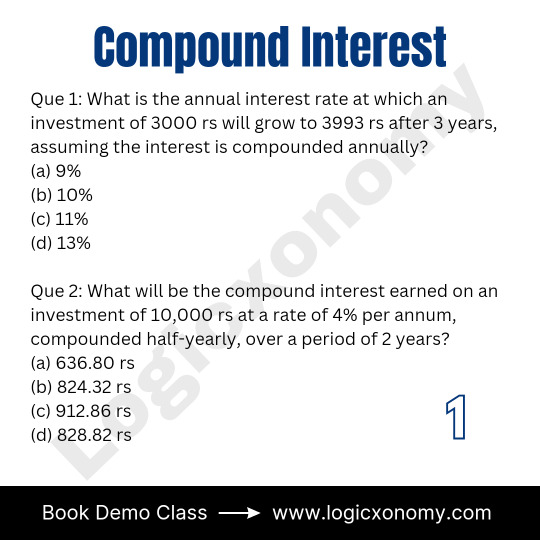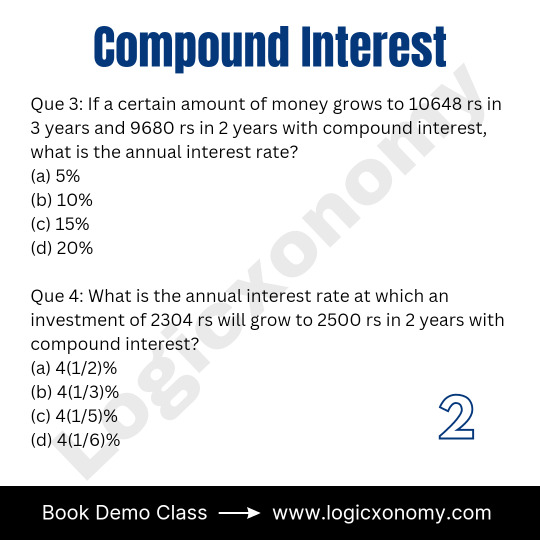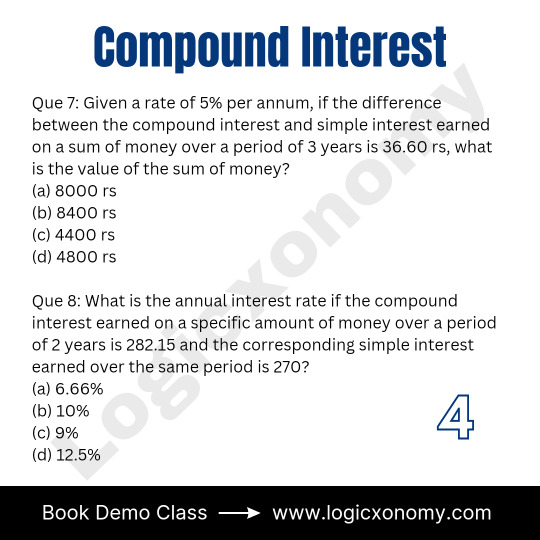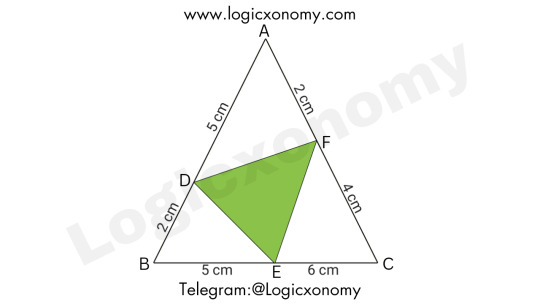#logicxonomy
Explore tagged Tumblr posts
Text
Solving LCM and HCF Puzzles: Finding the Number of Pairs

Learn how LCM and HCF concepts help you solve complex problems, find the number of pairs, determine divisors and factors, and crack math puzzles. Enhance your number theory skills and boost your chances of success in these competitive exams. Don’t miss out on this essential topic that can make a significant difference in your exam performance!
Que: How many pairs of integers (x,y) exist such that the product of x,y, and HCF(x,y)= 1080?
(a) 8
(b) 7
(c) 9
(d) 12
Total Pairs=9
Option (c) is correct.
Que: Find the least number that should be added to 2014 such that the resulting number can be divided by 3,4,5, and 6 leaving no remainder.
(a) 34
(b) 60
(c) 36
(d) 26
youtube
The LCM and HCF concepts are very useful in solving problems involving fractions, simplifying algebraic expressions, and finding solutions to equations. Some questions based on LCM and HCF concepts are as follows:
Find the LCM and HCF of two or more numbers
Simplification of fractions
Find the smallest or largest number satisfying given conditions
Calculate the time taken by two or more persons to complete a task working together.
Total number of rotations or revolutions required by two or more wheels to come back to their initial position
Find the least n-digit number which when divided by the given numbers leaves the same or different remainder.
How many pairs of numbers are there whose product is given
Arrangements in rows and columns, etc.
— — — — — — — — — —
Click Here for detailed concepts
Telegram Channel: Logicxonomy
0 notes
Text
How to find the number of divisors

In this article, we will explore the divisor concepts, including the number of factors, prime factors, and the fascinating properties of the sum and product of factors. By understanding these concepts, you will gain valuable insights into the relationships between numbers and unlock the secrets hidden within their divisors.
The divisor or factor of any number divides it without leaving any remainder. For example, let’s consider the number 12. The divisors or factors of 12 are 1,2,3,4,6 and 12.
To find the total number of divisors of any number, we use the prime factorization method given below.
For example, the prime factorization of any number (N) is p^a×q^b×r^c, Here p,q, and r are the prime numbers (2,3,5,7,11,…etc.) and a,b, and c are their respective exponents.
The total number of divisors of N= (a+1)×(b+1)×(c+1)
Example: Find the number of divisors of 360
360=2³×3²×5¹
The number of factors= (3+1)×(2+1)×(1+1)=24
24 factors= {1,2,3,4,5,6,8,9,10,12,15,18,20,24,30,36,40,45,60,72,90,120,180,360}
Que 1: Find the number of prime factors of 360.
Solution: Three Prime factors={2,3,5}
Que 2: Find the number of odd factors of 360.
Solution: Remove 2³ from the prime factorization
Remaining Part= 3²×5¹
Number of odd factors= (2+1)×(1+1)=6
Que 3: Find the number of even factors of 360.
Solution: 360=2³×3²×5¹=2×[2²×3²×5¹]
Even Factors= 2K
K=2²×3²×5¹
Number of even factors= (2+1)×(2+1)×(1+1)=18
Que 4: Find the number of factors of 360 that are divisible by 12.
Solution: 360=2³×3²×5¹=2²×3×[2¹×3¹×5¹]
Required factor=12K
K=[2¹×3¹×5¹]
Number of required factors= (1+1)×(1+1)×(1+1)=8
Que 5: Find the number of factors of 360 which are perfect squares.
Solution: 360=2³×3²×5¹
Possible pairs={(2⁰, 2²)×(3⁰, 3²)×(5⁰)}
Number of required factors= 2×2×1=4
— — — — — — — — — — — — — —
Click the given link for more details
Telegram Channel: Logicxonomy
0 notes
Text
Complex Percentage Money Distribution Problem: Expert Techniques for a quick solution

Que 1: If A, B, C, and D share a loot as follows: A receives a% of the total, B receives b% of the remaining (after A takes their share), C also receives c% of the remaining, and D gets the rest, where D’s share is a% less than what A gets, B and C get equal amounts, and b is equal to 2a. What percentage of what A received did C get?
(a) 160%
(b) 80%
(c) 175%
(d) 50%
Solution: Let the total amount= 100 rs
A⇒a
B⇒(100-a).b/100= (100-a).2a/100
C⇒(100-a).2a/100
D⇒a.(100-a)/100
A+B+C+D=100
5a.(120-a)=10000
a=20
A=20%=20
B=40% of 80=32
C=32
D= 80% of A=16
C received= 160% of the A
Option (a) is correct
Que 2: What is the range of values x can take if an alloy of copper and aluminum has 40% copper, an alloy of copper and zinc has a copper-to-zinc ratio of 2:7, and when these two alloys are mixed in such a way that the overall alloy has more aluminum than zinc, with copper constituting x% of this alloy?
a) 30% ≤x ≤40%
b) 32.5% ≤x ≤42%
c) 33.33% ≤x ≤42%
d) 32.25% ≤x ≤40%
youtube
Telegram Channel: Logicxonomy
0 notes
Text
Challenging Simple and Compound Interest Mix Problems: Tricky Solution

Que: A person borrowed a certain amount of money from a private organization at a simple interest rate of 5% per annum. He lent out 50% of this amount to another individual at a compound interest rate of 10% per annum. As a result, he earned a profit of Rs. 3,205 in 4 years. What was the initial amount borrowed by the person?
(a) 80,000
(b) 1,00,000
(c) 1,20,000
(d) 1,50,000
Que: Given a rate of 5% per annum, if the difference between the compound interest and simple interest earned on a sum of money over a period of 3 years is 36.60 rs, what is the value of the sum of money?
(a) 8000 rs
(b) 8400 rs
(c) 4400 rs
(d) 4800 rs
In this intriguing problem, we dive into the world of simple and compound interest. Join us as we unravel the solution to a challenging scenario involving borrowing, lending, and calculating profits.
In this YouTube video, we present a step-by-step breakdown of the problem and its tricky solution. Discover how a person borrowed a certain amount of money at a simple interest rate of 5% per annum and then lent out 50% of this amount to another individual at a compound interest rate of 10% per annum. After 4 years, the person earned a profit of Rs. 3,205.
Through detailed explanations and strategic problem-solving techniques, we unravel the mystery of the initial amount borrowed by the person. You’ll gain valuable insights into simple interest, compound interest, rates, and profits.
youtube
Telegram Channel: Logicxonomy
0 notes
Text
Shaded Area Ratios in Parallelograms: Practice Problems and Solutions| Geometry tricks

Que: In the parallelogram ABCD, where IJ is parallel to AD, and ED and HF are perpendicular to DC, what is the ratio of the areas of quadrilateral AGJI to triangle HFC?
Solution: In △ADE, GJ∥AE
So, ar(△GJD): ar(△AED)=GD²: AD²=9:25
ar(AEJG)= 25–9= 16 unit …………..(i)
△IEJ ~△GJD (Similar Triangles)
ar(△IEJ): ar(△GJD)=IJ²:GD²=4:9
ar(△IEJ)=4 unit ………(ii)
ar(△HFC)=ar(△GJD)=9 unit
ar(AGJI): ar(△HFC)=16–4: 9=12:9= 4:3
— — — — — — — — — — — — — — —
Home Work Question
In the rectangle ABCD, the diagonal AC is extended to point E such that CE measures 5 cm. If the lengths of sides AB and BC are 8 cm and 6 cm respectively, what is the length of DE?
youtube
Telegram Channel: Logicxonomy
0 notes
Text
Profit and Loss Assignment:2





Que 1: What is the cost price of an article if the profit on selling it for Rs. 425 is equal to the loss on selling it for Rs. 355?
(a) 410
(b) 380
(c) 400
(d) 390
Solution: CP-355=425-CP
CP=390
Option (d) is correct
Que 2: If the cost price of 10 articles is equal to the selling price of 15 articles, what is the percentage of profit or loss incurred on the transaction?
(a) 25.5%
(b) 35%
(c) 10%
(d) 33.33%
Solution: CP×10=SP×15
CP: SP=3:2
Loss=33.33%
Option (d) is correct
Que 3: If a trader incurred a loss of 10% on selling a cycle and could have gained 6% had the selling price been increased by Rs. 200, what was the cost price of the cycle?
(a) 1200 rs
(b) 1205 rs
(c) 1250 rs
(d) 1275 rs
Solution: 90%+200=106%
16%=200
1%=25/2
100%=1250
Option (c) is correct
Que 4: If A sold an article to B at a profit of 20% and B sold it to C at a loss of 15%, what profit or loss would A make if he had sold the article directly to C at the same selling price as B?
(a) 5% profit
(b) 2% profit
(c) 2% loss
(d) 5% profit
Solution: A: B=5: 6
B: C=20: 17
A: B: C= 100: 120: 102
A makes 2% profit
Option (b) is correct
Que 6: If a shopkeeper sells rice at a profit of 10% while using a weight that is 30% less than the actual measure, what is the percentage of profit that the shopkeeper earns?
(a) 57.67%
(b) 57.14%
(c) 57.40%
(d) 57.43%
Solution: SP= Price per unit× No. of Units
Weight⇒ 10: 7
SP⇒ 10: 11
Price= 10/10: 11/7= 7: 11
Percentage Profit= 400/7= 57(1/7)=57.14%
Option (b) is correct
— — — — — — — — — — — — — —
Click the given link for details
Telegram Channel: Logicxonomy
0 notes
Text
Simple and Compound Interest Assignment:1





Que 1: What is the annual interest rate at which an investment of 3000 rs will grow to 3993 rs after 3 years, assuming the interest is compounded annually?
(a) 9%
(b) 10%
(c) 11%
(d) 13%
Solution: 3000: 3993
1000: 1331
Cube root both sides⇒ ∛1000: ∛1331= 10:11
Annual interest rate= 10%
Option (b) is correct.
Que 2: What will be the compound interest earned on an investment of 10,000 rs at a rate of 4% per annum, compounded half-yearly, over a period of 2 years?
(a) 636.80 rs
(b) 824.32 rs
(c) 912.86 rs
(d) 828.82 rs
Solution: 4% per annum= 2% half yearly
10000⇒ 10000+200=10200
10200⇒ 10200+204=10404
10404⇒ 10404+208.**=10612.**
10612⇒ 10612+212.**= 10824.**
Option (b) is correct.
Que 3: If a certain amount of money grows to 10648 rs in 3 years and 9680 rs in 2 years with compound interest, what is the annual interest rate?
(a) 5%
(b) 10%
(c) 15%
(d) 20%
Solution: 9680: 10648
1210: 1331⇒ Difference or CI= 121
Option (b) is correct.
Que 4: What is the annual interest rate at which an investment of 2304 rs will grow to 2500 rs in 2 years with compound interest?
(a) 4(1/2)%
(b) 4(1/3)%
(c) 4(1/5)%
(d) 4(1/6)%
Solution: 2304:2500
Square root both sides⇒ √2304: √2500= 48: 50
Interest rate= 200/48= 25/6= 4(1/6)%
Option (d) is correct.
Que 5: Assuming a compound interest rate of 4% per annum for the first year, 5% per annum for the second year, and 6% per annum for the third year, what will be the total compound interest earned on an investment of 10,000 rs for 3 years?
(a) 1600
(b) 1625.80
(c) 1575.20
(d) 2000
Solution: 10000⇒ 10000+400=10400
10400⇒ 10400+520= 10920
10920⇒ 10920+ 654.**=11574.**
CI= 1574.**
Option (c) is correct.
— — — — — — — — — — — — — — — —
Click the given link for more details
Telegram Channel: Logicxonomy
0 notes
Text
The Concepts of Surds and Indices

Surds and indices are two important mathematics concepts often studied in high school and college-level mathematics courses. They are used extensively in algebraic and geometric computations and play a crucial role in many areas of science and engineering.
Surds are irrational numbers that cannot be expressed as a ratio of two integers. They are typically expressed in the form of √n, where n is a non-square positive integer. For example, the square root of 2 (√2) is a surd, as is the cube root of 3 (∛3) or the fifth root of 7. Surds can be added, subtracted, multiplied, and divided just like other numbers, but their irrational nature can sometimes produce unexpected results when manipulated.
Indices, also known as exponents or powers, are shorthand notations used to express the repeated multiplication of a number by itself. For example, 3² (read as “3 to the power of 2”) is shorthand for 3 × 3 = 9. Similarly, 4³ (read as “4 to the power of 3”) is shorthand for 4 × 4 × 4 = 64. Indices can also be negative or fractional, which allows them to represent roots and reciprocal powers. For example, 5⁻² (read as “5 to the power of negative 2”) is shorthand for 1/5² or 1/25, and ∛2 (read as “the cube root of 2”) is shorthand for 2^(1/3).
Surds and indices are often used together in mathematical expressions, particularly when working with roots and fractional exponents. For example, the expression √2 × 2^(-1/2) can be simplified by recognizing that √2 is the same as 2^(1/2) and that 2^(-1/2) is the reciprocal of 2^(1/2), so the expression simplifies to 1.
— — — — — — — — — — —
Click the given link for more details
Telegram Channel: Logicxonomy
0 notes
Text
What are the Incenter, Inradius, and Incircle of a Triangle? | Geometry Explained

In this video, we will explain these fundamental concepts of geometry in an easy-to-understand manner.
We will begin by defining what the incenter, inradius, and incircle of a triangle are, and then move on to explore their properties and how they relate to each other. You will learn how the incenter is the center of the circle inscribed within the triangle, the inradius is the radius of that circle, and the incircle is the circle inscribed within the triangle itself.
We will also cover some practical applications of these concepts, such as how they are used in finding the area and perimeter of a triangle. By the end of the video, you will have a solid understanding of the incenter, inradius, and incircle of a triangle, and be able to apply this knowledge to solve a variety of geometry problems.
youtube
Telegram Channel: Logicxonomy
0 notes
Text
One-to-One Quants and Reasoning Classes for CAT 2023

Hello, I am Rajnikant Mishra, a highly experienced and qualified educator based in Delhi NCR. I hold a Master’s degree in Technology from Amity University and a Bachelor’s degree in Technology from Uttar Pradesh Technical University. For the past 8 years, I have been teaching��Quantitative Aptitude and Reasoning Ability to students preparing for competitive exams such as CAT, SSC, Banking, and CLAT, at various reputed coaching institutions in the Delhi NCR region in offline mode. Currently, I am providing personalized online classes to a maximum of 5 students per batch, ensuring individual attention and a highly interactive learning experience.
Features of my course include:
Personalized attention with a maximum of 5 students per class, which is impossible in large offline classrooms or low-fee online live classes.
Two-way communication is possible, and students can ask their doubts during the live classes due to limited students.
Classes are available in both Hindi and English languages.
Students will have access to regularly updating premium recorded videos, blogs, online mock tests, and PDF notes for 1 year after the completion of live classes.
Daily 45-minute to 1-hour Online sessions for 5 days a week.
youtube
Telegram Channel: Logicxonomy
0 notes
Text
Find the area of Quadrilateral ABCD

Find the area of quadrilateral ABCD, If ∠BAC=35°, ∠ACD=10°, ∠ADC=45°, and side AB=10 cm.
Solution: Flip the triangle CAD vertically and arrange it as shown in the picture

Now △ABD is an isosceles triangle because its two angles are 45°.
AB=BD=10 cm
Area of the △ABD=½×Base×Height
=½×10×10
=50 cm²
— — — — — — — — — — — — — — — —
Click the link for more concepts
Telegram Channel: Logicxonomy
0 notes
Text
The ratio of shaded areas in Geometry

Que: Find the ratio of the areas of △DEF and △ABC.
Solution: ar(△DAF)= ½×AD×AF×Sin(A)
ar(△ABC)=△=½×AB×AC×Sin(A)
ar(△DAF): ar(△ABC)= AD×AF : AB×AC= (AD/AB)×(AF/AC): 1
ar(△DAF)= (AD/AB)×(AF/AC)×△

ar(△DAF)= (5/7)×(2/6)×△=(5/7)×(1/3)×△
ar(△DBE)= (2/7)×(5/11)×△
ar(△ECF)= (6/11)×(4/6)×△=(6/11)×(2/3)×△
ar(△DEF)= △-△×[(5/7)×(1/3)+(2/7)×(5/11)+(6/11)×(2/3)]
= (62/231)×△
ar(△DEF): ar(△ABC)= 62: 231
— — — — — — — — — — — — —
Click the given link for more details
Telegram Channel: Logicxonomy
0 notes
Text
Properties of the triangle (Incenter)

Here, I is equidistant from all the sides of the triangle. so this is the Incenter of the triangle. I is the intersection point of all the angle bisectors of the triangle.
CI:IG=(AC+BC):AB= 14:5
So, ar(△AIB): ar(△ABC)=IG: CG= 5:19
Let the area of △ABC=19k
So the area of △AIB=5k
AG:GB=AC: BC=8:6=4:3 (Angle bisector theorem)
ar(△AIG)=(AG/AB)×ar(△AIB)
=(4/7)×5k
=20k/7
ar(△AIG): ar(△ABC)=20k/7: 19k
=20/7:19
=20:19×7
=20:133
— — — — — — — — — — —
Click the given link for more concepts
Telegram Channel: Logicxonomy
0 notes
Text
Distance between the incenter and Vertex of the triangle

In the given triangle ABC, side lengths a=13 cm, b=14 cm, and c=15 cm. If the length of the inradius is ‘r’ and Circumradius is ‘R’.
Semi-Perimeter of the triangle (s)=(a+b+c)/2=21 cm
Area of the triangle (△)= 84 cm²
△²=s.(s-a)(s-b)(s-c) ………Heron’s formula
Inradius (r)=△/s=4 cm
Circumradius (R)=abc/4△= 65/8 cm
AI×BI×CI=4Rr²
=4×65/8×4²
=520
— — — — — — — — — — —
Click the given link for detailed concepts
Telegram Channel: Logicxonomy
0 notes
Text
Sine and Cosine Concepts of Triangle

In this given triangle ABC, sides a=13 cm, b=14 cm, and c=15 cm. If ‘r’ is the inradius and ‘R’ is the circumradius of the triangle then
r=△/s
△²=s.(s-a).(s-b).(s-c)
Semi-perimeter (s)= (13+14+15)/2=21
△=84 cm²
r=△/s=84/21=4 cm
R=abc/4△= 65/8 cm
Sin(A/2).Sin(B/2).Sin(C/2)=r/4R= 8/65
Cos(A/2).Cos(B/2).Cos(C/2)=s/4R=42/65
— — — — — — — — — — —
Click the given link for detailed concepts
Telegram Channel: Logicxonomy
0 notes
Text
Problems on Cyclic Quadrilateral

Question: In the given figure AB=1 cm, CD=4 cm, and DP: PB = 8 : 3 then find the area of the incircle.
Solution: △DCP is similar to △ABP
∠DCA = ∠ABD (Angles subtended by the same chord AD, on the boundary)
∠DPC = ∠APB (Vertically opposite angles)
Given, DP=8x & PB=3x
So, DP/AP=CP/PB=DC/AB
8x/AP=CP/3x=4/1
CP/3x=4/1
CP=12x
8x/AP=4/1
AP=2x
△DAP is similar to △CBP
∠DAC = ∠CBD (Angles subtended by the same chord DC, on the boundary)
∠DPA = ∠CPB (Vertically opposite angles)
So, DP/PC=AP/PB=AD/BC
8x/PC=2x/3x=AD/BC
AD/BC=2/3
Let, AD=2y & BC=3y
Use Theorem: AB + DC = BC + AD
1+4=3y+2y
y=1
So, AD=2 & BC=3
The area of the Cyclic Quadrilateral ABCD, (Use Brahmagupta’s Formula)
k²=(s-a)(s-b)(s-c)(s-d)
a= 1, b=3, c=4, d=2, and s=5
So, k=√24 cm²
To find the area of the incircle use formula: k=s×r
5×r=√24
r=√24/5
Area of incircle =πr²=24π/25 cm²
— — — — — — — — — —
Click Here for more study material
Telegram Channel: Logicxonomy
0 notes